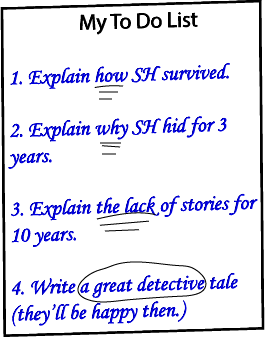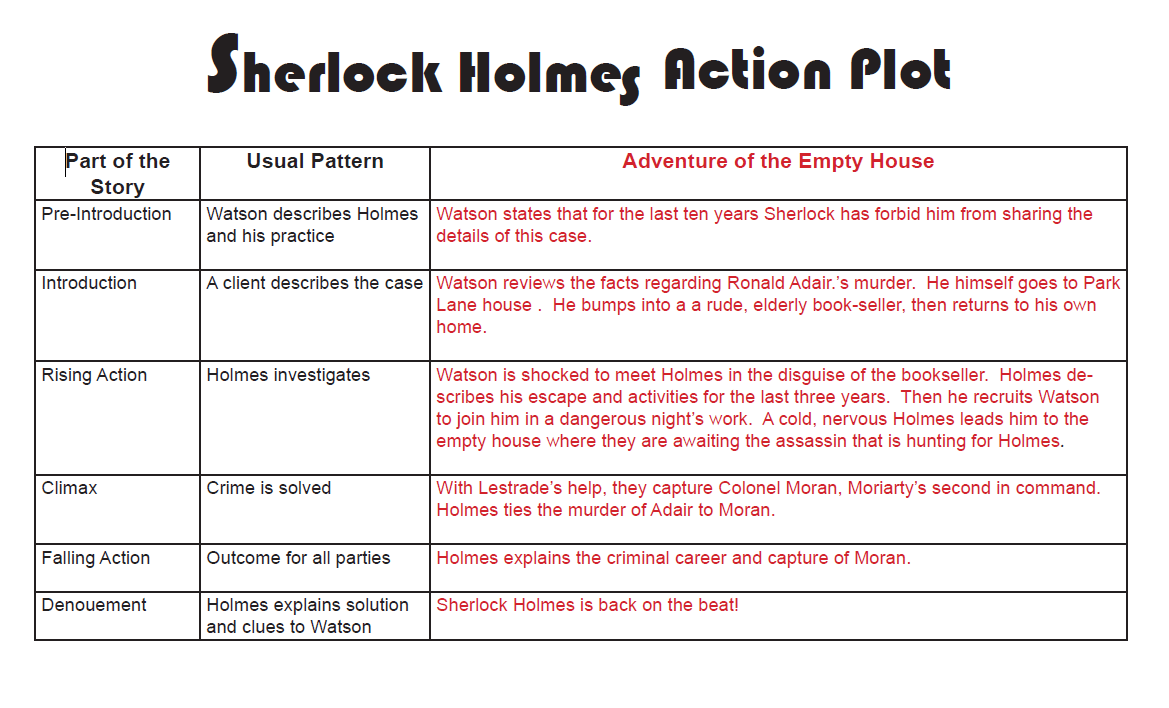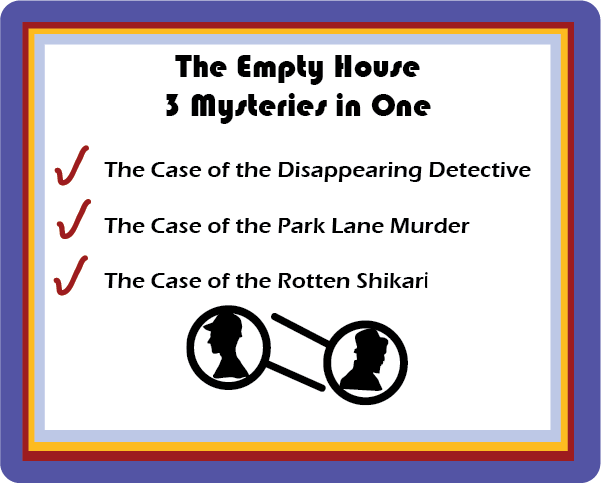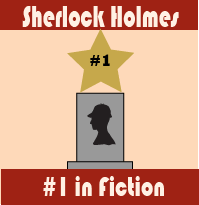Adventure of the Empty House
#F-25
Our analysis of The Adventure of the Empty House details how the hunter-becomes-hunted in this 3-for-1 tale.

This is not a summary of this story but an analysis of some of its unique features. If you haven't read it, you really should!
Dating of the Story
- Setting of the story: April 1894
- Date recorded by Watson: According to Watson, Holmes allowed him to release this story ten years after it happened, or in 1904.
- First published by Doyle in The Strand: October 1903
- Published in Book Form: 1917 The Return of Sherlock Holmes - the third collection of short stories
For more than a century!
A Tale Like No Other
The Adventure of the Empty House stands alone in many ways. This is the first story after Sherlock Holme's death. It was published a full ten years after Doyle had startled the public by plunging his hero to his death in The Final Problem.Doyle has a lot to accomplish in this 25th short story:
- Explain to the public how his character survived the plummet at Reichenbach Falls
- Explain to Watson also how he survived - and why he kept his survival a secret
- Reestablish Holmes in his role as the world's foremost consulting detective (to Doyle's public and Sherlock's public)
- Remake the Holmes and Watson partnership.
- Return Holmes to the good graces of Inspector Lestrade and Scotland Yard
- Do all of this convincingly and reestablish the connection between his abandoned public and his foremost fictitious character.
Reestablish Holmes as the world's favorite detective, reconnect with his adoring public, and win their forgiveness and trust? Absolutely!
Do so convincingly? Well.....maybe. From a literary standpoint it worked. But people are still trying to work out some of the details so maybe it could have used a little tweaking.
But without doubt, this story was and is a success. It remade Sherlock Holmes AND made literary history.
Unique In Its Opening
We have listed the 3 different types of starters to the Sherlock Holmes stories. The Adventure of the Empty House starts with a power statement:It was in the Spring of the year 1894 that all of London was interested and the fashionable world dismayed by the murder of the Honorable Ronald Adair under most unusual and inexplicable circumstances.Openings with power statements or declarations get the readers attention. Unlike other power statements, this is not an eye-opening fact about Sherlock.
And if there was any story where the public wanted - yea demanded - to know about Sherlock it was now.
Too bad. They have to hold off their curiosity a little while longer and consider the fact that ALL of London was spell-bound by the peculiar murder of one of their own politicians.
So, Doyle has succeeded with his opening power statement of getting the attention of:
- All of London AND the fashionable world
- All the Sherlock fans
- A lonely and subdued Dr. Watson
Unique In Its Action Plot
The Adventure of the Empty House has it's own unique twists and turns compared to the usual Sherlock Holmes action plot.- Pre-Introduction - Describes to the public that they have had to wait ten years for these details because Sherlock made him hold off the publication. (Meanwhile, the public doesn't know how he survived.)
- Introduction - Watson himself reviews the details of the current case, which he himself set out alone to investigate in his lonely state.
- Rising Action - An amazing reunion, a quick (and maybe not entirely satisfactory) description of Sherlock's escape and travels, and the two again are sneaking off on a dangerous mission together.
- Climax - Sherlock captures his tiger which is no surprise to his readers. But said readers and Watson and Lestrade are surprised that Colonel Moran is also Adair's murderer.
- Falling Action - The daring detective explains how Moran became involved in this case.
- Denouement - And once again, the readers can rest assured that Sherlock is on the case and more short-stories will be coming.
Rising Action and Falling Action
A unique thing about the Rising and Falling Action: they both tell about Colonel Moran.- Rising Action: Moran's quest to find Holmes
- Falling Action: Moran's murder of Adair
Unique In Its Case
The Empty House: 3 Mysteries in One
Doyle gave us three cases in one:- Case of the Disappearing Detective: Where had Sherlock been for 3 years?
- Case of Park Lane Murder: A classic who-dunn-it in a locked-room detective murder
- Case of the Rotten Shikari: An honorable officer lives a dishonorable double life
Case of the Disappearing Detective
This is the case most of us are most interested in. The public waited ten long years to get their hero back. But where had he been and why?Doyle attempted to answer that question but his answers raise more questions. Read more about that below.
The Park Lane Murder
This classic locked-room detective story is at the heart of this tale, but often gets overlooked with all eyes on Sherlock.A dead man with no enemies and no clues - it would take Sherlock himself to solve this case. Fortunately for Lestrade, Sherlock HAS been watching the papers looking for this very thing.
Holmes was hiding, waiting for his savvy enemy to slip up. But the Colonel was cautious. Confronted by the young Adair about card-cheating, however, his temper overcame his discretion.
Four clues (see below) unraveled the case to the hidden Sherlock, while stumping Scotland Yard and the public.
The Case of the Rotten Shikari
This is the only Sherlock tale in which the hunter becomes the hunted. Or in Holme's words: "the watchers were being watched and the trackers tracked."Like the double-agent in a spy story, Doyle and Sherlock twist this tale on its tracks. Holmes isn't content to remain the hidden-one-in-hiding. He bides his time to catch his own tiger.
The Baker Street Empty House is the "tree" in this dramatic metaphor:
Have you not tethered a young kid under a tree, lain above it with your rifle, and waited for the bait to bring up your tiger? This empty house is my tree, and you are my tiger. You have possibly had other guns in reserve in case there should be several tigers, or in the unlikely supposition of your own aim failing. These - he pointed around - are my other guns. The parallel is exact."

Brilliant plot that connects all three cases!
Unique in Watson's Role
Watson was, of course, the prototype of the superhero's trusted sidekick. The public accepted that he would be the eyes from which Sherlock could be watched.As Holmes' assistant, Watson assumed different roles throughout the stories.
Here's what we see in The Empty House.
- Solo Investigator - He begins as the lonely detective's assistant. He is no longer in Sherlock's employ, but in his own inadept manner, attempts to solve the kinds of crimes that had fascinated his departed friend.
- Detective's Assistant - Holmes calls upon him within a few hours after his return to London.
- First Holmes returns to Baker Street and puts Mrs. Hudson into hysterics.
- "I found myself in my old arm chair in my old room, and only wishing that I could see my old friend Watson in the other chair that he has so often adorned."
- Holmes DID make a little side trip as an elderly bookseller, however, before calling upon Watson.
- Finally he shows up, makes Watson faint, gives him his explanation for his 3 year absence (see below), then calls upon him with the words, "I have a piece of work for us both to-night which, if we can bring it to successful conclusion will, in itself, justify a man's life on this planet."
- This explanation is apparently good enough for Watson, who goes off with Holmes without further explanation.
- Body Guard - Watson notes in the next paragraph, "I found myself seated beside him in a hansom, my revolver in my pocket and the thrill of adventure in my heart." Ah this is how his readers always liked him best. It's a good thing he went armed, too, because the colonel seized Holmes by the throat and it was Watson's revolver used as a club that rescued Holmes.
- Friend - It is heartening to note in the quote above that Holmes refers to Watson as "his old friend." There are a few other ways in which the friendship is reflected:
- He specifically obtained Moriarty's permission to write the farewell note to Watson before the scuffle.
- Holmes stated he had "taken up my pen to write to you but I always feared lest your affectionate regard for me should tempt you to some indiscretion."
- Well, it was a lame excuse, in my opinion, but at least he DID think of Watson. Sort of.
Widower of Mary Morstan
In all of the other shocks and surprises of this story, readers are expected to take full note of the meaning of this single sentence:In some manner he had learned of my own sad bereavement, and his sympathy was shown in his manner rather than his words.So in those 23 words, the followers of the Sherlock canon understand that Watson's wife, Mary Morstan, is dead. We don't know how she died. We aren't sure how long ago she died, though it would appear it was relatively recently (certainly less than three years.)
Okay. She's gone. Moving on.
Hold on, a minute! Exactly what is going on here and why? We last saw Watson bereaved of his buddy Sherlock but able to be comforted in the arms of his beloved Mary. Now we exchange the buddy for the wife. Fair enough, I guess.
I will note, without any attempt at persuasion, that there are some who feel Mary didn't die, but just got tired of Watson and his gambling and skipped town. While strict adherents to the story-line hold to the traditional view that Watson married twice (Mary Morstan and an unknown wife mentioned once in 1902) some chronologists give him four or more wives. I tend to stick with just two wives and move on.
But why did Doyle do away with Mary?
There's a simple answer. With a married Watson, the stories always had a little awkward start when he had to disclose a scenario that brought the two of them face-to-face and ready to embark on another case. Watson may not have liked being a bachelor but the public preferred it.
They won. That's why Holmes was resurrected and if Mary has to die to keep the public happy, so be it.
Unique in Its Excuse, er, Reason for Hiding
Below I present a modern paraphrase of the information spoken by Holmes in the two stories The Final Problem and The Empty House. Events are recorded in the chronological order in which they occurred and not in the order in which Sherlock disclosed them.Timeline of Sherlock Holmes Disappearance After Reichenbach Falls
- I really thought Moriarty was likely to kill me. I had already made my will anyway and left everything to Brother Mycroft.
- I knew the Swiss messenger was fake when you left me at Reichenbach to return to the hotel in Meiringen.
- Moriarty and I had a little discussion of how he had escaped the police. He allowed me to write the letter I left you.
- I walked back along the ledge with Moriarty "on my heels." At the end of the path, Moriarty rushed at me.
- Thanks to baritsu, I won. He fell with a scream.
- "With my face over the brink, I saw him fall for a long way."
- I realized there were at least three others who would track me down for revenge. "One or the other would certainly get me."
- These three men would "take liberties" if they thought I was dead, and then I could find and destroy them.
- Even while I was watching him fall, I decided to go into hiding.
- I climbed the very steep, treacherous cliff. I almost died, but no one would see my footprints and figure I was alive. I thought I heard Moriarty screaming at me which was a bit freaky.
- I finally reached a ledge between the path where we fought and the very top. I laid there in comfort. (Apparently catching his breath from the steep, scary, almost fatal climb.)
- Meanwhile, you returned with others (it took him over an hour per Watson's statement in Final Problem) and I watched your investigation in comfort and silence.
- Ya'all left and I thought "I had reached the end of my adventures."
- Someone from the top threw a rock down that came within a foot of my head. I looked up and saw one of Moriarty's confederates who had seen the whole thing.
- I scrambled back down the cliff I just came up. Halfway down I slipped but "by the blessing of God I landed torn and bleeding."
- I fled. Fast.
- A week later I was in Florence with "the certainty that no one in the world knew what had become of me."
- I got in touch with Mycroft so he could send me money.
- Sorry 'bout keeping you in the dark, ol' fellow. But your account (writen two years after the fall) wouldn't have been so convincing. I mean, your affectionate regard, and all that.
- The London trial of the Moriarty gang did not go as well as I had hoped and "left two of its most dangerous members ... at liberty."
- The itenerary of my travels under the name of Sigerson: two years in Tibet, then to Persia, then France.
- At least once I have "reported to the Foreign Office." (Remember, Government-Official-Mycroft is in on the Big Secret.)
- I finished my research in "coal-tar derivitives" in South France. (Hey, did you know Sherlock Holmes helped invent acetominophen or Tylenol?)
- I learned that "only one of my enemies was left in London" so figured it about time to return.
- I commissioned Monsieur Oscar Meunier of Grenoble to make a wax bust of my head and upper body. (Exactly when in the three years this occurred we aren't sure, but with a French name it was likely when he was in France, his last abode before returning to London.)
- I was planning on coming back to London soon anyway. But then I heard about the Park Lane murder and thought "Whoa Nellie, I recognize Moriarty's gang here and better get back post-haste." (modern translation)
- I brought the wax bust back with me.
- When I arrived at Baker Street apartment this morning, I saw Parker, a sentinel placed by Moriarty's associates who have been watching my door the entire time because they "and only they knew" that I was alive.
- Entering 221 Baker Street, I "threw Mrs. Hudson into violent hysterics and found that Mycroft had preserved my rooms and papers exactly as they had always been."
- I figured that since Parker knew I was back in town, Moran would know I had figured out the Adair-thing and try to get rid of me this very night.
- I set up the wax bust and instructed Mrs. Hudson to crawl on her knees and turn the figure every 15 minutes. But I had to wait until her hysterics were over to give the instructions. Sigh! Women!
- So at 2 pm today I was sitting in my old chair, looking at your old chair, and wishing to see "my old friend Watson."
- I disguised myself as a bookseller. (Probably leaving out a back window so Parker thought he was still inside.)
- I made contact with Inspector Lestrade (by telegram perhaps) and arranged for him to be on hand outside Baker Street. There was no face to face contact between us.
- This evening I went to the Park Lane House, maintained my disguise as a bookseller because they are after me.
- I kept my disguise when I bumped into you because I didn't want you to give away my presence there.
- So at 9:30 tonight we will begin a new dangerous adventure. You will come, won't you?
- How about a bite of dinner? And oh yeah, about your grief, work is the best antidote. Wouldn't you agree?
Contradictions in The Empty House
So this account leaves many Sherlockians scratching their collective heads.WHY Was Watson Not Informed?
I get the whole thing about making the plan to go into hiding while watching Moriarty fall. But then when he observed his enemy's confederate above him and flees for his life, the entire premise seems to fall apart.Why should he care if others know that Watson knows he alive, when they themselves know he is alive?
Who Escaped the Law?
At first Holmes thought the entire gang except Moriarty were all captured (Final Problem). "They have secured the whole gang with the exception of him. He has given them the slip."While Moriarty was falling, Holmes realized there are three of them out to get him. (See #7 in timeline above.)
After the Moriarty Gang trial there are only two confederates left. Then after his coal-tar derivatives research he finds there is only one left. (Compare #20 and #24. Did the other two die or get captured? We'll never know.)
Apparently Parker isn't counted as one of the associates. And you would have to have more than one sentinel watching a door for three years. The numbers seem a little bit off.
Up On the Ledge
According to Watson (Final Problem) "It may have been a little over a hour before I returned to Meiringen." (It's about five miles of mountain paths.) Make it two hours for the full return trip to Reichenbach Falls, assuming it doesn't take any time for him to get together a company of followers. (The followers are mentioned in The Empty House by Holmes but not in The Final Problem by Watson.)In that two hours Holmes writes the letter, engages the enemy and wins the combat, climbs the cliff and rests. If you see pictures of the cliff you realize it would take a while. But not two hours. So he was resting for a little bit on that shelf. Of course, he still had a further way to go up.
Here comes the investigators. That would be interesting to watch, now, wouldn't it? No rock has been flung down on him yet, so he still plans on hiding out.
They leave, and a rock comes whizzing down to crush his head. The associate takes this opportunity to begin his assassination attempt. So, just what were the two of them doing for most of the last two hours?
No Guns?
Moriarty, the most dangerous criminal agent alive, and commissioner of the air-gun Holmes feared, did not shoot him.He drew no weapon but he rushed at me and threw his long arms around me.
And then Moran, the finest shot in Europe and Asia also had no weapon. After watching his hated target rest for several hours, he threw a rock at him.Something must have happened to their firearms. They got wet in the Falls?
Anyway, we can all be glad Moriarty and Moran forgot their guns or got them wet or whatever happened.
In short, we have a few difficulties with the narrative. Previously we have looked at the reason for the contradictions in the Sherlock stories. Many of the contradictions are related to the development of the canon while it is being written. (He published the stories as he wrote them. Authors of chapter books go back and change the early chapters to smooth out their story lines and fix their contradictions.)
But these bloopers are all in the same story; and a story Doyle had ten years to think about.
Oh well, that's why Doyle was more interested in his more serious writing. He didn't take Sherlock nearly as seriously as everybody else does.
How Did Holmes know Moran killed Adair?
Holmes mentions he hurried back to London because the Park Lane murder not only "appealed to me on its own merits" but it also "seemed to offer some most peculiar personal opportunities."Translation: I recognized this was the opportunity I had been waiting for.
So, just how did Sherlock recognize Moran's involvement in the Adair Murder?
"Knowing what I did was it not certain that Colonel Moran had done it?"
- Sherlock knew Moriarty had comissioned the air gun made by "Von Herder, the blind German mechanic." (He was afraid of the air gun in The Final Problem when he sought refuge at Watson's house.) This gun used soft, expandable bullets.
- Adair was shot through the head by a very skilled marksman.
- At the inquest it was revealed that Adair had played cards with Moran the night of his murder.
- Moran was a cheater at cards "of that I had long been aware."
A Closer Look At Holmes

Holmes was cold and stern and silent.
He was quivering with silent laughter.
Three years had certainly not smoothed the asperities of his temper or his impatience with a less active intelligence than his own.
Again in the utter silence I heard that thin, sibilant note which spoke of suppressed excitement.
The sardonic smile that occasionally broke through his ascetic gloom boded little good for the object of our quest.
Sherlock is Still Sherlock (Flippant as ever.)
Sherlock appears to spare Mrs. Hudson and Watson his usually glib comments at their first meetings. He probably figured making Watson faint and putting his housekeeper into violent hysterics was sarcasm enough for one day.But he couldn't be expected to hold back for the whole day.
His Greeting to Lestrade
But you handled the Molesey Mystery with less than your usual - that's to say you handled it fairly well.Lestrade probably had to think about that to figure out if it was a compliment or an insult.
His Greeting to Moran
"Ah Colonel," said Holmes arranging his rumpled collar. "Journeys end in lovers meetings' as the old play says. I don't think I have had the pleasure of seeing you since you favored me with those attentions as I lay on the ledge above the Reichenbach Fall."
His Assessment of the Baker Street Sentinel
Holmes had this to say about Moran's henchman watching his apartment building:He is a harmless enough fellow, Parker by name, a garroter by trade and a remarkable performer on the jew's harp.
DICTIONARY:- Garroter: someone who kills another by strangling them with an iron chain or collar
- Jew's harp: a mouth harp which plays musical notes
So here's a rough modern translation:
He is a harmless enough fellow, Parker by name, an assassin by trade and a remarkable performer on the kazoo.
His Valuation of Watson's Investigation
There I was stretched when you, my dear Watson, and all your following were investigating in the most sympathetic and inefficient manner the circumstances of my death. When you had all formed your inevitable and totally erroneous conclusions you departed for the hotel.
The Stature Of Holmes
We all know what Holmes looked like. At least sort of. We get bits and pieces thrown in from story to story. Here's what this tale affords us:- I felt the thin, sinewy arm beneath
- It is no joke when a tall man has to take a foot off his stature for several hours on end.
- Tall spare figure and the keen, eager face
- Holmes's cold thin fingers closed around my wrist and led me forward down a long, thin hall
Holme's Methods
Holme's frequently refers to "his method" and scholars and hobbyists continue to try to develop exactly what that method might be. Here is a pointer in The Empty House for those data sifters:To find that least line of resistance which my poor friend had declared to be the starting-point of every investigation.
Holme's Diverse Talents
For those of you keeping a list of Sherlock's amazing resume of talents, you simply must add Japanese wrestling to the list:I have some knowledge, however, of baritsu, or the Japaneses system of wrestling, which has more than once been useful to me.
About These Stories, Watson
Fictitious transparency refers to Holmes and Watson referring to the very stories they are in which is an interesting literary angle, to say the least.- We mentioned in the first paragraph that Watson explained he waited ten years to publish this account because Sherlock required it. (No reason is given for why that would be.)
- He did not write to Watson because Watson's account of Holme's death was sooooooo much more believable with Watson in the dark.
- He calls Watson's stories "fairy tales" when he refers to the Baker Street apartment as "the starting point of so many of your little fairy tales." (Ouch!)
Unique Ending of the Story: A New Beginning
Doyle frequently ended Sherlock Holmes stories with sarcasm. Both The Final Problem and The Empty House are tales that DON'T end with the characteristic flippancy.We end with this comment:
Once again Sherlock Holmes is free to devote his life to examining those interesting little problems which the complex life of London so plentifully presents.
This is what the public wanted and their author delivered!This story ends as it begins: with a power statement which stands in contrast to its opening power-statement. Instead of being baffled by an unsolved mystery, the public can be confident that more Sherlock stories will be coming their way.
Baker Street Treasure Hunt
Here's an object I bet most of the scavengers on our Baker Street Object Hunt will find:A wax bust
My Recommendation
True confession: Arthur Conan Doyle never asked for my input into his stories. The fact that he died before my birth is partially responsible for this. As the world's best-selling fiction-writer, he just might have skipped my help even if we had been contemporaries.But this is one of those stories that just begs to have its weak points edited. It is such a fantastic tale, it made literary history, why not just eke out a few corrections and make the whole thing precisely perfect?
What Should Have Been:
- While Moriarty was "giving me a sketch of the methods by which he avoided the English police and kept himself informed of our movements" (from the letter written by Holmes minutes before the Reichen-Scuffle) he also disclosed that the three Moriarity confederates were imminently hot on the trail of Holmes and Watson.
- The contest by the Falls between Confederate-Moran and Holmes occured before Watson and followers arrived to investigate. By the time they got there, Holmes was gone.
- Instead of being the most inconsiderate friend in the world, Holmes heroically led Moran away from Watson so he could go back home to his happy married life.
- In his jigsaw travels, Holmes followed Moran to the East and worked to disrupt Moran's communication with the other two surviving Morarity gang-members. Hence, the need for radio-silence with Watson.
- Siegerson's name was a childhood code-name between he and Mycroft. Hence Holmes could communicate with Mycroft via any Foreign Office. It was Mycroft who chose not to share such intelligence with Watson.
- Continue the back and forth hunter-and-hunted drama until we end up at the Park Lane murder.
Not that it matters at this point, but it would be nice to smooth out a few of those loose ends.
Watch It
I'm always a fan of reading and not watching literature and Sherlock Holmes tales are no exception. However, I will make a rare exception here. The Grenada series with Jeremy Brett as Sherlock Holmes excelled at sticking to the original. Their edition of The Empty House is beautifully done and recommended for anyone who enjoyed this story.The unit study below analyzes eight of the most popular Sherlock Holmes stories. While The Adventure of the Empty House is not one of the eight in this unit study the preceding story The Final Problem is included.
Buy Sherlock Holmes: The Unit Study
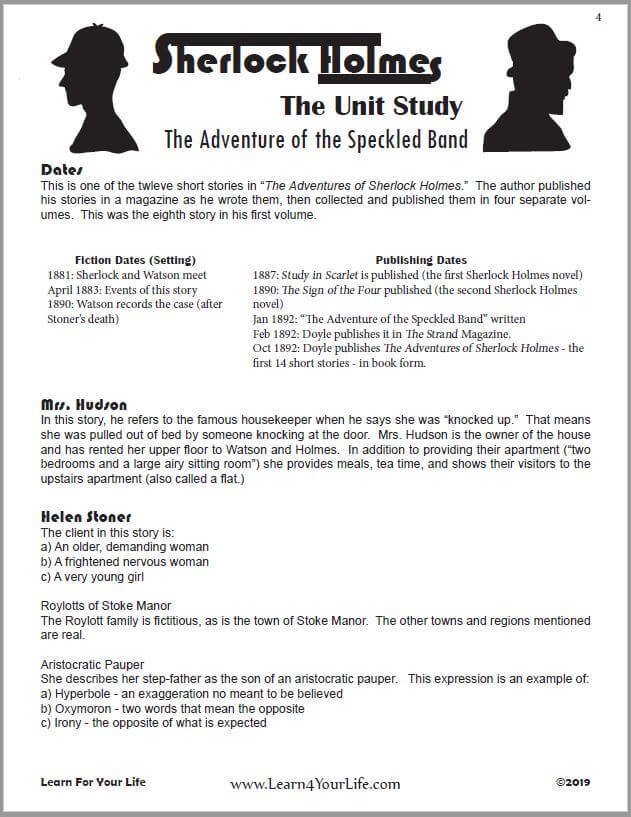
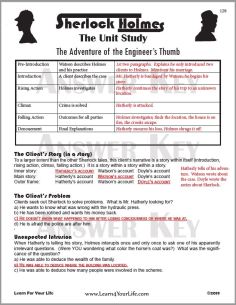
Student Guide AND Teacher's Answer Key Included
$2.99 Download - 183 pages
Eight of the most popular tales demonstrate how to investigate a detective story.
![]()
Sherlock Holmes Pages
A catalog of our pages on Sherlock Holmes.
About Our Site
Hands-On Learning


